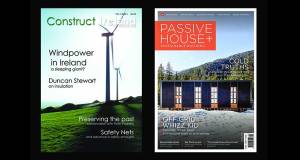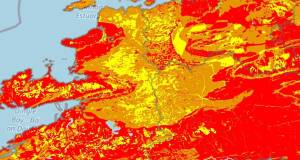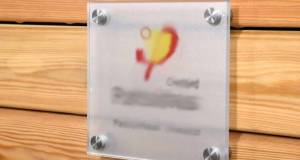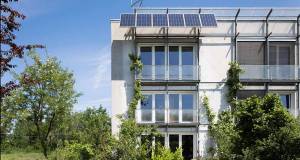 Vivienne Brophy, Dr Irena Kondratenko, Patxi Hernandez and Kevin Burke
Vivienne Brophy, Dr Irena Kondratenko, Patxi Hernandez and Kevin Burke
- Passive Housing
- Posted
Passive Potential

The Passive House standard, an internationally renowned approach to building that negates the need for conventional heating, has attracted considerable interest in Ireland recently as energy prices continue to rise. Vivienne Brophy, Dr Irena Kondratenko, Patxi Hernandez and Kevin Burke of UCD’s Energy Research Group look at the effect this approach could have on cutting Ireland’s energy consumption and CO2 emissions.
The significance of these figures is highlighted by the fact that Ireland’s greenhouse gas emissions were 23.5% greater than 1990 levels in 2004 despite a Kyoto Protocol target of +13% between 2008-2012 [EPA 2006]. With the EU Energy Performance of Buildings Directive (EPBD) due for implementation between 2006 and 2009 the awareness of building energy performance will increase substantially. Given these issues an ideal opportunity exists for the Passive House concept to be accepted into the construction of Irish dwellings.
Mandatory building regulations concerning the conservation of fuel and energy in dwellings, Technical Guidance Document - Part L (TGD Part L) were first introduced to Ireland in 1991, were amended in 1997 and again in 2002. The TGD Part L focuses on reducing energy consumption primarily by reducing required U-values, increasing insulation levels and minimizing thermal bridging. However, with two passive houses constructed in Ireland since 2002, the gap in standards between TGD Part L and the Passive House standard has been highlighted. Not only are Passive House minimum U-values for ground floor, wall, roof and windows significantly less than TGD Part L, as seen in Figure 2, but Passive House standards go much further by setting requirements for air tightness, passive solar gains and heat recovery whereas Irish regulations do not. The term Passive House refers to a specific construction standard for residential buildings with good comfort conditions during winter and summer, without traditional heating systems and without active cooling. A passive house has a high level of insulation with minimal thermal bridges, low infiltration and utilises passive solar gains and heat recovery to accomplish these characteristics. Consequently renewable energy sources can be used to meet the resulting energy demand.
• The total energy demand for space heating and cooling is limited to 15 kWh/m² treated floor area; and
• The total primary energy use for all appliances, domestic hot water and space heating and cooling is limited to 120 kWh/m².
In light of the awaited proposed amendment to TGD Part L and development of a calculation procedure for energy rating for Irish dwellings to comply with the EPBD, the UCD Energy Research Group undertook a study investigating the potential reduction for space heating energy and CO2 emissions when the Passive House space heating standard of 15kWh/m2 is applied to the Irish new build residential construction market
The tool used in this study was a computer-based model, developed as part of the “Homes of the 21st Century“ study [Brophy et al. 1999], which profiled the existing national dwelling stock by dwelling form, insulation characteristics and heating system types. The model was used to predict the energy consumption and CO2 emissions of dwellings with a typical floor area of 100m2, constructed to 2002 building regulation standard. This provided national common practice energy consumption and CO2 emissions figures for electricity, gas, oil and solid fuel (such as coal and peat).
For the purposes of determining the CO2 emissions of a Passive House a 50:50 split between the use of gas and wood pellets was assumed as a space heating energy source. By comparing these figures it was possible to establish the variation in energy consumption and CO2 emissions between national common practice and Passive House standard for one typical dwelling.
Using this data, five scenarios representing varying levels of application of the Passive House Standard were investigated. These scenarios, detailed in Table 1, represent the energy and CO2 emission saving potential of a low, medium, high, very high and as standard application of the Passive House standard.
Although new dwelling construction figures indicate that over 80,000 dwellings were constructed in 2005 it is likely that the new build rate will decline over the next 20 years. For this reason the five scenarios investigated were applied to approximately the average new build dwelling construction of the past 20 years of 40,000 dwellings.
Using the calculation model it was found that a typical Irish dwelling, constructed to 2002 building regulations standard, consumes 9,722 kWh/year of delivered energy on space heating and as a result releases 2,855 kgCO2/year into the atmosphere. The space heating requirements for the same size of dwelling built to Passive House standards was found to be only 1,500 kWh/year of delivered energy which equates to 176 kgCO2/year. The difference in delivered energy consumption and carbon dioxide emissions between the two construction types for a single building over one year was therefore 8,222 kWh/year and 2,680 kgCO2/year.
Applying potential energy and CO2 emissions saving rates to the 20 year average new build dwelling construction rate of 40,000 homes per year the following results were calculated.
Although in recent years Ireland has tightened up its regulations concerning dwelling energy performance, the results presented above indicate that substantial savings are achievable in this area. This assumes that all built dwellings comply with TGD Part L. Evidence of a ‘very low level’ of compliance was found within a recent energy performance survey of Irish housing, commissioned by SEI and carried out by CODEMA and DIT, which suggests that in reality greater savings may be achievable. In striving to meet Ireland’s Kyoto Protocol commitment and in implementing the EPBD, an ideal opportunity exists for the application of the Passive House standard to Ireland. Given the evidence of the benefits of its application the reasons for the current lack of penetration of the Passive House concept in Ireland need to be addressed. Lack of knowledge in the public domain of those benefits may be a primary barrier to increased penetration. By increasing public awareness to the potential savings that Passive House standards could achieve over traditional constructions and reinforcing the fact that increased energy performance does not mean decreased comfort conditions (and often could mean an improvement in comfort conditions) a significant increase in Passive House application in Ireland may be achieved.

Authors Note:This article has been written based on a conference paper on the study presented at the 10th International Passive House Conference in Hanover, Germany, on 19-21 May 2006, within the framework of the Promotion of European passive Houses (PEP). The PEP project is partially supported by the European Commission under the Intelligent Energy Europe Programme. The objective of the PEP project is to promote the potential of the European Passive House concept in Europe by the development of information packages and design tools for passive houses, the organization of (inter) national workshops, symposia and conferences and the set up of an international passive house website.
Further information available on the PEP project web site: http://www.europeanpassivehouses.org
Authors
Vivienne Brophy, Dr Irena Kondratenko, Patxi Hernandez and Kevin Burke, UCD Energy Research Group, School of Architecture, Landscape and Civil Engineering, University College Dublin, Richview, Belfield, Dublin 4, Ireland.
Tel: +353 (1) 269 2750
References
[Brophy et al. 1999] Brophy, V., Clinch, J.P., Convery, F.J., Healy, J.D., King, C. and Lewis, J.O.. Homes for the 21st Century – The Costs & Benefits of Comfortable Housing for Ireland. Report prepared for Energy Action Ltd. Dublin: 1999
[DOEHLG 2002] Department of the Environment, Heritage and Local Government, 2002. Technical Guidance Document Part L: Conservation of fuel and energy.
[DOEHLG 2006] Department of the Environment, Heritage and Local Government, 2006. Housing Statistics.(Accessed March 2006) Click here to read
[EPA 2006] Environmental Protection Agency, 2006. Ireland’s Emissions of Greenhouse Gases – Revised and Updated Figures.
[SEI 2005] Sustainable Energy Ireland, 2005. Energy Consumption and CO2 Emissions in the Residential Sector: 1990-2004. SEI Energy Policy Statistical Support Unit.
- Articles
- Passive Housing
- Passive Potential
- passive house
- Standard
- UCD
- Energy Research Group
- emissions
- energy consumption
- building regulations
- part l
- kyoto
Related items
-
Scotland to accept passive house as regs compliant
-
 Much ado about nothing
Much ado about nothing -
 Decarbonising buildings “most important issue” – Climate Change Committee
Decarbonising buildings “most important issue” – Climate Change Committee -
 Big picture - New Zealand rural passive home
Big picture - New Zealand rural passive home -
 Podcast: what we've learned from 20 years in green building mags
Podcast: what we've learned from 20 years in green building mags -
 45,000 more Irish homes face radon risk, new maps reveal
45,000 more Irish homes face radon risk, new maps reveal -
 Passive house 30 years on: qualified success or brilliant failure?
Passive house 30 years on: qualified success or brilliant failure? -
 Techrete aims for net zero carbon by 2030
Techrete aims for net zero carbon by 2030 -
Disappointment at new building energy standards
-
 Above the curve - Limerick passive house showcases precision timber engineering
Above the curve - Limerick passive house showcases precision timber engineering -
 International passive house conference kicks off
International passive house conference kicks off -
 Grant launches online learning academy
Grant launches online learning academy




